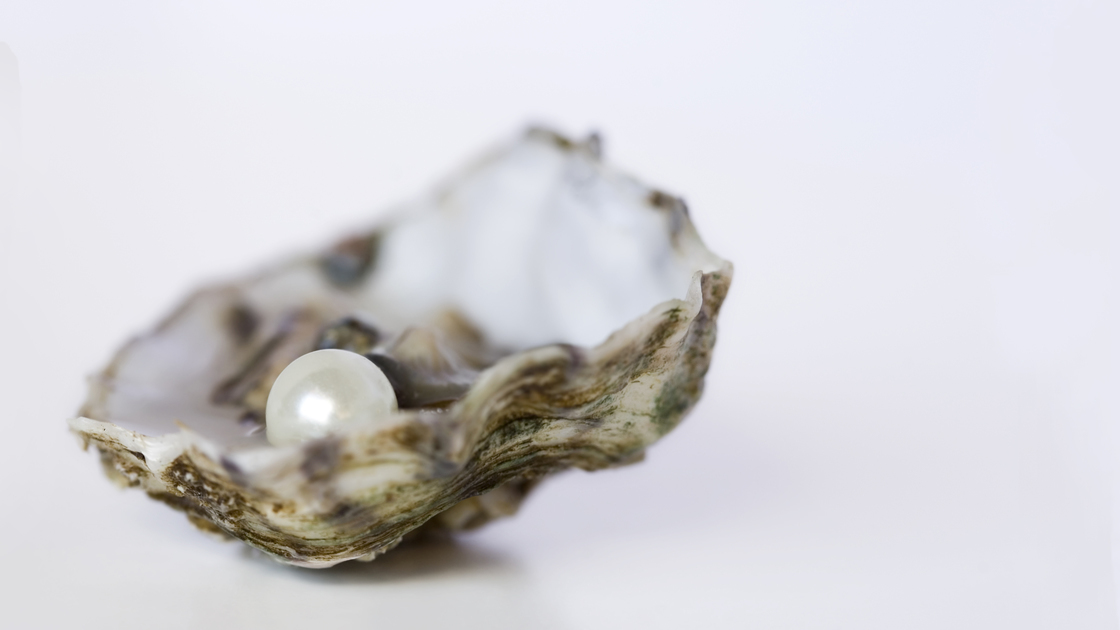Think of something rare.
What did you come up with? Maybe you thought of diamonds, maybe you thought of money, or maybe, like the French philosopher Jean de la Bruyère, you thought of a spirit of discernment as being rare. Whatever you thought of, throw some pearls into the mix. A natural, perfect pearl is extremely rare.
Pearls are formed as an oyster’s defense mechanism. Oysters are bivalve mollusks, meaning they have a two-part hinged shell. When a foreign object—like a grain of sand or a parasite—somehow wiggles its way into the oyster, the mollusk reacts as if it’s saying, “Ow!” The foreign object lodges itself in the soft inner body of the oyster and interrupts the oyster from feeding on plankton. This causes the oyster pain, probably similar to getting a painful splinter in your finger. Because it is unable to get rid of the rude intruder, the oyster turns on its defense mechanism. The oyster secretes a hard, translucent substance around the foreign object, coating it evenly and smoothly. This substance that the oyster uses to cover up the intruder is called nacre.
Seeking more comfort, the oyster keeps smoothly covering the imposter with more nacre. As long as the intruder stays inside the soft cocoon of the oyster, layer after layer of nacre will be added to it. After a few years, the nacre builds up a strong, shiny shell around the intruder, and thus a pearl is born.
The most amusing part of this process is probably that pearls are formed because a bivalve mollusk has been irritated, but the most amazing part of this process has to do with the nacre. Nacre is lighter and stronger than concrete. Nacre is not just a special Band-Aid, but it’s a substance that is made out of countless microscopic crystals. When light hits one of these little crystals, it reflects onto the other crystals surrounding it, and they deflect the light, making the pearl look glossy and colorful. Because of this brilliant characteristic, pearls are popular, prized, sought after and even reproduced. But even with advanced technology and science, mankind has been unsuccessful at re-creating pearls without the presence of an oyster because nacre is not replicable.
Any mollusk that has a shell—including mussels and clams—can also accomplish the feat of forming a pearl, although it is much rarer. Sometimes the pearls are white, but they can also be grey, black, red, blue, green or yellow. Pearls aren’t always round, either; they appear in a variety of shapes and sizes. Uneven pearls are called baroque pearls and are even more diverse.
Pearls are commercially produced today using oysters. Oyster farms insert small objects into the mollusks to get the process going, and voila! More pearls! Depending on the pearl and the process used, it takes somewhere between six months to several years to form a pearl. That is a long time, and there is no guarantee it will be perfect. The most valuable pearls are flawlessly round and shimmery, but a pearl of value is found in less than one out of every 10,000 natural oysters.
So while we all wait for some mollusks to produce more perfect pearls, here are some assorted pearl facts to keep us busy. First, pearl oysters are born male and turn into females once they live for about three years. Weird, huh? Also, pearls are the only gemstone created by animals. They are pretty dangerous to harvest when they form naturally; in the 19th and 20th centuries, the mortality rate for pearl divers was as high as 50 percent due to shark attacks and the painful effects of the bends (or decompression sickness) when returning to the surface.
The different colors of pearls depend on the color of the inside of the shell where it is formed. No two pearls are the same. Every pearl has imperfections—even so-called perfect pearls. Most pearls that you see today are cultured (human- or farm-made) pearls. Pearls appear to have always been a status symbol; a legend exists that Cleopatra once dissolved a pearl earring in vinegar and drank it to flaunt her lavish lifestyle to Marc Antony. I don’t know about you, but that doesn’t sound exactly healthy to me. Or delicious.
Matthew 13:45-46 says, “Again, the kingdom of heaven is like a merchant man, seeking goodly pearls: Who, when he had found one pearl of great price, went and sold all that he had, and bought it.” This scripture shows that a perfect pearl is of immense value, worth everything you have. This scripture is actually referring to the opportunity to be in the Kingdom of God—it is rare and priceless! A perfect pearl only comes around every once in a while—just like the chance to be in God’s Kingdom.
If we have been given the opportunity to be called into the Kingdom of God, it is worth more than anything else in this world. And just like the merchant was willing to give up all that he had, we must take advantage of this awesome opportunity that God has given us. It is worth far more, and is far more rare, than the most perfect pearl ever made.
